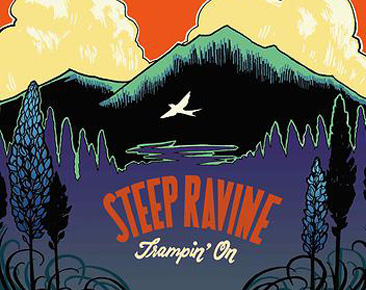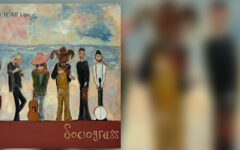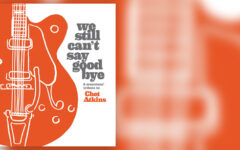
 Bluegrass music is often praised for its driving rhythm and fast, hot picking – particularly on the banjo. However, there’s another side to bluegrass ingenuity, often with a more laidback sound, that fully embraces bluegrass music’s connections to jazz and folk music. Steep Ravine, a new quartet from the San Francisco area, has a tight grasp on this second side of bluegrass. Their debut album, Trampin’ On, is easygoing and peaceful, yet still features fine musicianship, enjoyable melodies, and a unique blend of acoustic genres.
Bluegrass music is often praised for its driving rhythm and fast, hot picking – particularly on the banjo. However, there’s another side to bluegrass ingenuity, often with a more laidback sound, that fully embraces bluegrass music’s connections to jazz and folk music. Steep Ravine, a new quartet from the San Francisco area, has a tight grasp on this second side of bluegrass. Their debut album, Trampin’ On, is easygoing and peaceful, yet still features fine musicianship, enjoyable melodies, and a unique blend of acoustic genres.
The album’s eleven tracks are all band originals, and with the exception of two, were written by guitarist and lead vocalist Simon Linsteadt. The music is a smooth mixture of gentle folk, melodic jazz, and bluegrass-inspired instrumental solos (particularly on the part of fiddler Jan Purat). Linsteadt’s lyrics are poetic, introspective at times while seemingly inspired by old-time and classic bluegrass numbers at others.
Several of the songs here deal with a subject that’s quite familiar in traditional music – leaving home. The album opens with one of these traditionally-inspired songs, Prairie Rose. A tale of a young man who leaves his sweetheart at home while he goes off to ramble, it has a wistful feel.
The title track also has a rambling theme, with its repeated phrase, “Ain’t a sound more beautiful than your boot heels trampin’ on.” The music on this track is laidback, with a gentle bluesy groove. Closing out the record is C’mon Home, one of the album’s standout tracks. The song ambles along to a nice, steady rhythm that perfectly matches the singer’s contemplations on walking, climbing, and roaming.
Wooden Floors starts out with a bluesy vibe, but picks up some jazzy effects along the way. It has the kind of expressive lyrics that folk and indie groups tend to favor these days, and wouldn’t sound too out of place on one of John Mayer’s more recent records. The enjoyable Wildflower Honey, a love song of sorts, has a bright, toe-tapping melody on the edge of contemporary bluegrass. Linsteadt’s instrumental tune, Where the River Runs Deep and Green, is a tasteful guitar-led piece that captures the feel of a gentle river nicely.
The two tracks not written by Linsteadt, Purat’s instrumental Ponderosa and mandolin player Andy O’Brien’s No. 37, are, for the most part, the grassiest numbers here. Ponderosa is uptempo and nicely performed, with a feel somewhere between Italy and the Old West. The band describes it as “Alpine gypsy-grass,” which, interestingly enough, fits. No. 37, on the other hand, is a cheerful, light mandolin tune not too far removed from mainstream contemporary bluegrass.
While bluegrass traditionalists may be turned off by the band’s lack of banjo, it’s easy to not miss it on this album. The band members are all very clearly talented musicians and they come together as a great, cohesive unit here. Purat’s fiddling stands out in particular throughout the album, although Linsteadt’s solid, jazz-inspired guitar work, O’Brien’s fine mandolin playing, and bass man Alex Bice’s strong, tight rhythm should be praised, as well. Fans of the folky, jazzy style of bluegrass played by groups like Della Mae should definitely take time to listen to this debut from Steep Ravine.
For more information on Steep Ravine, visit their website at www.steepravineband.com. Their album can be purchased from several online music retailers.







